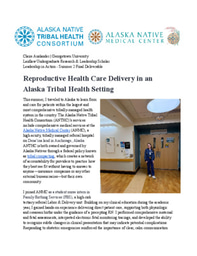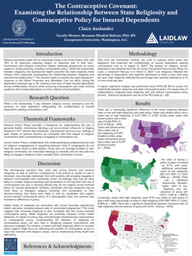Research Outline: Examining The Relationship Between State Religiosity and Contraceptive Policy
Abstract
Americans are engaged and committed to their religious communities, with over seventy percent deeming religion an important part of their lives. Moreover, involvement with religious institutions shapes individual perspectives on issues related to family planning, including contraceptive policy. While the relationship between religiosity and health outcomes, including reproductive health outcomes, has been explored (Chen, 2022; Kachoria, 2022; Piccinini, 2021; Strayhorn & Strayhorn, 2009), there remains a lack of scholarship investigating the relationship between state contraceptive policy and religiosity. As a result, this study will examine the relationship between religious service attendance and policy related to confidentiality for insured dependents seeking contraceptive care, a policy group closely impacted by the social and cultural influences of religiosity. To study this, I will conduct a review of the literature and then use Stata BE to perform a descriptive analysis to compare state contraceptive policy and religious service attendance data. This project seeks to aid policymakers and clinicians in better understanding the connection between state-wide demographic religious practice and reproductive health policy, particularly considering that most such laws surface under state legislatures (Rice, 2022).
Research Objectives & Questions
Research Question
What is the relationship between religious service attendance and state legislation regarding the confidentiality of insured dependents seeking contraceptive care?
Research Objective
Study results will strictly describe the relationship between state policy and religious practice data at the state level. My research highlights the need to investigate how varying levels of religious influence within states may shape legislative approaches to contraceptive policy, specifically regarding privacy protections in healthcare.
Background
Religiosity
Religion permeates public life for individuals living in the US, with a significant majority—70%—of Americans considering religion to be of importance, and 41% attending religious services on a weekly or monthly basis (Gallup). Citizens’ engagement with their religious community, including interactions with religious organizations working with pregnant and parenting people, contribute to individual perspectives on these issues and shape beliefs surrounding related legislation (e.g., employer-sponsored insurance coverage of birth control). Americans’ commitment to their faith communities is underscored by the fact that 59% of churchgoers have attended their current congregation for over a decade, while the average tenure an employee maintains with their employer is only 4.1 years.
Insurance Coverage of Contraceptives
The Affordable Care Act (ACA), enacted in 2010 with most key provisions taking effect by January 2014, drastically changed the landscape of contraceptive coverage in the United States at the federal level. Before the ACA, many health insurance plans typically terminated dependent coverage at age 19 or upon completion of full-time education (typically around age 22). However, the ACA raised this limit to 26 years old, allowing many young adults to remain on their parent’s plan—irrespective of marital, financial, student, or employment status.
Explanation of Benefits Forms (EOBs) are documents sent by insurers to policyholders after anyone covered under their policy obtains medical care. These documents usually include the name of the individual receiving care, the healthcare provider, and the type of care obtained—essentially making it impossible for dependents, commonly minors and young adults ages 18-26, to obtain confidential access to sexual and reproductive healthcare services. Legislation aimed at safeguarding dependent confidentiality often requires minor’s consent for disclosure, which is the default practice at Title X clinics (and part of why patients choose to seek family planning care at these sites).
Religiosity and Contraceptive Use
Looking at religiosity through a demographic lens reveals associations between religious affiliation with contraceptive choice and utilization. Almost all women who identify as religious have ever used a contraceptive drug or device—99% of evangelical Protestants, mainline Protestants, and Catholics, and 96% of people with other religious affiliations. Compared to Protestants, Catholics are more likely to use non-ad hoc methods of birth control (eg., the pill, progestin implant).
Research examining the relationship between individual religiosity and contraceptive use has produced mixed findings: some suggest a negative relationship between the two, others find a positive relationship, and some find no significant correlation. For instance, low and moderately religious women are at least twice as likely as their highly religious counterparts to use non-ad hoc hormonal contraceptives. Highly religious women are far more likely to use coital (at the time of intercourse) methods, namely condoms, compared to low and moderately religious women.
Methodology
This study has two phases: a literature review and a descriptive analysis. In phase one, I will conduct a review of the literature on contraceptive policies and religiosity trends in the US to assess the latest developments across these two fields. I generated mesh terms and formulated a search strategy in consultation with a public policy research librarian at Lauinger Memorial Library. The review of the literature will span two weeks.
In phase two, I will use Stata BE under the direction of my faculty mentor, Dr. Mirabal-Beltran, to conduct a descriptive analysis (Aggarwal, 2019), including tabulations and frequency percentiles. Variables will be created for state contraceptive policy and compared to religious service attendance data. Religious service attendance will be defined categorically as at least once a week, once or twice a month/a few times a year, and seldom/never, using original source labels from the Pew Research Center’s Religious Landscape Study. Data extraction, cleaning, and analysis will take two to three weeks.
Since no primary data collection is involved and all data is publicly accessible, no IRB approval is required.
Potential Impact
My research explores how religious values and doctrines influence public policy decisions, especially in pluralistic societies where diverse religious beliefs coexist. Policies regarding contraception, particularly those influenced by religious beliefs, can impact individuals' ability to access and afford birth control methods. Furthermore, this research could serve as a backdrop for discussion on the relationship between religiosity, public policy, and healthcare access on the international stage.
Resources & Support Needed
I extend gratitude and thanks to my mentor, Dr. Roxanne Mirabal-Beltran, whose expertise as a researcher and clinician has proven invaluable to this project. I would also like to thank Megan Hunt, Data and Public Policy Librarian at Lauinger Memorial Library, for her guidance as a research librarian on the project. Finally, I would like to extend my gratitude to the Laidlaw Foundation, whose funding has provided me with the dedicated time and resources to pursue the fellowship this summer.



Please sign in
If you are a registered user on Laidlaw Scholars Network, please sign in